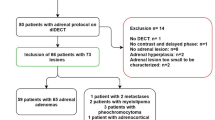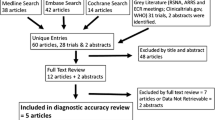Abstract
Purpose
To evaluate whether single-phase dual-energy-CT-based attenuation measurements can reliably differentiate lipid-rich adrenal adenomas from malignant adrenal lesions.
Materials and methods
We retrospectively identified 51 patients with adrenal masses who had undergone contrast-enhanced dual-energy-CT (140/100 or 140/80 kVp). Virtual non-contrast and colour-coded iodine images were generated, allowing for measurement of pre- and post-contrast density on a single-phase acquisition. Adrenal adenoma was diagnosed if density on virtual non-contrast images was ≤10 HU. Clinical follow-up, true non-contrast CT, PET/CT, in- and opposed-phase MRI, and histopathology served as the standard of reference.
Results
Based on the standard of reference, 46/57 (80.7 %) adrenal masses were characterised as adenomas or other benign lesions; 9 malignant lesions were detected. Based on a cutoff value of 10 HU, virtual non-contrast images allowed for correct identification of adrenal adenomas in 33 of 46 (71 %), whereas 13/46 (28 %) adrenal adenomas were lipid poor with a density ≥10 HU. Based on the threshold of 10 HU on the virtual non-contrast images, the sensitivity, specificity, and accuracy for detection of benign adrenal lesions was 73 %, 100 %, and 81 % respectively.
Conclusion
Virtual non-contrast images derived from dual-energy-CT allow for accurate characterisation of lipid-rich adrenal adenomas and can help to avoid additional follow-up imaging.
Key Points
• Adrenal adenomas are a common lesion of the adrenal glands.
• Differentiation of benign adrenal adenomas from malignant adrenal lesions is important.
• Dual-energy based virtual non-contrast images help to evaluate patients with adrenal adenomas.



Similar content being viewed by others
References
Bovio S, Cataldi A, Reimondo G et al (2006) Prevalence of adrenal incidentaloma in a contemporary computerized tomography series. J Endocrinol Invest 29:298–302
Song JH, Chaudhry FS, Mayo-Smith WW (2008) The incidental adrenal mass on CT: prevalence of adrenal disease in 1,049 consecutive adrenal masses in patients with no known malignancy. AJR Am J Roentgenol 190:1163–1168
Dunnick NR, Korobkin M (2002) Imaging of adrenal incidentalomas: current status. AJR Am J Roentgenol 179:559–568
Dunnick NR, Korobkin M, Francis I (1996) Adrenal radiology: distinguishing benign from malignant adrenal masses. AJR Am J Roentgenol 167:861–867
Young WF Jr (2007) Clinical practice. The incidentally discovered adrenal mass. N Engl J Med 356:601–610
Lam KY, Lo CY (2002) Metastatic tumours of the adrenal glands: a 30-year experience in a teaching hospital. Clin Endocrinol (Oxf) 56:95–101
Young WF Jr (2000) Management approaches to adrenal incidentalomas. A view from Rochester, Minnesota. Endocrinol Metab Clin North Am 29:159–185, x
Blake MA, Cronin CG, Boland GW (2010) Adrenal imaging. AJR Am J Roentgenol 194:1450–1460
Yip L, Tublin ME, Falcone JA et al (2010) The adrenal mass: correlation of histopathology with imaging. Ann Surg Oncol 17:846–852
Legmann P (2009) Adrenal incidentaloma: management approaches: CT - MRI. J Radiol 90:426–443
Boland GW, Lee MJ, Gazelle GS et al (1998) Characterization of adrenal masses using unenhanced CT: an analysis of the CT literature. AJR Am J Roentgenol 171:201–204
Gnannt R, Fischer M, Goetti R et al (2012) Dual-energy CT for characterization of the incidental adrenal mass: preliminary observations. AJR Am J Roentgenol 198:138–144
Heye T, Nelson RC, Ho LM et al (2012) Dual-energy CT applications in the abdomen. AJR Am J Roentgenol 199:S64–70
Brown CL, Hartman RP, Dzyubak OP et al (2009) Dual-energy CT iodine overlay technique for characterization of renal masses as cyst or solid: a phantom feasibility study. Eur Radiol 19:1289–1295
De Cecco CN, Buffa V, Fedeli S et al (2010) Dual energy CT (DECT) of the liver: conventional versus virtual unenhanced images. Eur Radiol 20:2870–2875
Gupta RT, Ho LM, Marin D et al (2010) Dual-energy CT for characterization of adrenal nodules: initial experience. AJR Am J Roentgenol 194:1479–1483
Graser A, Johnson TR, Hecht EM et al (2009) Dual-energy CT in patients suspected of having renal masses: can virtual nonenhanced images replace true nonenhanced images? Radiology 252:433–440
Flohr TG, McCollough CH, Bruder H et al (2006) First performance evaluation of a dual-source CT (DSCT) system. Eur Radiol 16:256–268
Liu X, Yu L, Primak AN et al (2009) Quantitative imaging of element composition and mass fraction using dual-energy CT: three-material decomposition. Med Phys 36:1602–1609
Mayo-Smith WW, Boland GW, Noto RB et al (2001) State-of-the-art adrenal imaging. Radiographics 21:995–1012
Boland GW, Blake MA, Hahn PF et al (2008) Incidental adrenal lesions: principles, techniques, and algorithms for imaging characterization. Radiology 249:756–775
Ho LM, Marin D, Neville AM et al (2012) Characterization of adrenal nodules with dual-energy CT: can virtual unenhanced attenuation values replace true unenhanced attenuation values? AJR Am J Roentgenol 198:840–845
Zhang LJ, Peng J, Wu SY et al (2010) Liver virtual non-enhanced CT with dual-source, dual-energy CT: a preliminary study. Eur Radiol 20:2257–2264
Kim YK, Park BK, Kim CK et al (2013) Adenoma characterization: adrenal protocol with dual-energy CT. Radiology 267:155–163
Toepker M, Moritz T, Krauss B et al (2012) Virtual non-contrast in second-generation, dual-energy computed tomography: reliability of attenuation values. Eur J Radiol 81:e398–405
Graser A, Becker CR, Staehler M et al (2010) Single-phase dual-energy CT allows for characterization of renal masses as benign or malignant. Invest Radiol 45:399–405
Acknowledgements
The scientific guarantor of this publication is Prof. Dr. Anno Graser. The authors of this manuscript declare no relationships with any companies, whose products or services may be related to the subject matter of the article. The authors state that this work has not received any funding. No complex statistical methods were necessary for this paper. Institutional Review Board approval was obtained. Written informed consent was waived by the Institutional Review Board. Methodology: retrospective, diagnostic or prognostic study, performed at one institution.
Author information
Authors and Affiliations
Corresponding author
Additional information
A. Helck and N. Hummel contributed equally to this work.
Rights and permissions
About this article
Cite this article
Helck, A., Hummel, N., Meinel, F.G. et al. Can single-phase dual-energy CT reliably identify adrenal adenomas?. Eur Radiol 24, 1636–1642 (2014). https://doi.org/10.1007/s00330-014-3192-z
Received:
Revised:
Accepted:
Published:
Issue Date:
DOI: https://doi.org/10.1007/s00330-014-3192-z




